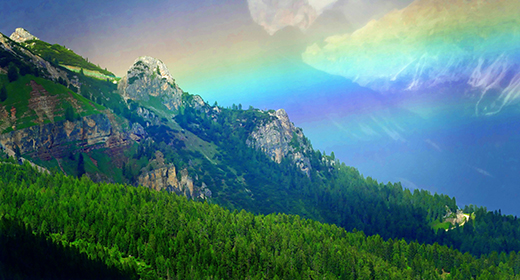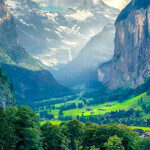by Richard Conniff: Urbanization is on the rise; so is the urban heat island effect—a situation that is worsening with the decline of tree cover in U.S. metropolitan areas…

Scientific evidence that trees and green spaces are crucial to the well-being of people in urban areas has multiplied in recent decades. Conveniently, these findings have emerged just as Americans, already among the most urbanized people in the world, are increasingly choosing to live in cities. The problem—partly as a result of that choice—is that urban tree cover is now steadily declining across the U.S.
A study in the May issue of Urban Forestry & Urban Greening reports metropolitan areas are experiencing a net loss of about 36 million trees nationwide every year. That amounts to about 175,000 acres of tree cover, most of it in central city and suburban areas but also on the exurban fringes. This reduction, says lead author David Nowak of the U.S. Forest Service (USFS), translates into an annual loss of about $96 million in benefits—based, he says, on “only a few of the benefits that we know about.” The economic calculation involves several such benefits that are relatively easy to express in dollar terms—the capacity of trees to remove air pollution, sequester carbon, conserve energy by shading buildings and reduce power plant emissions.
Nowak and a USFS colleague, co-author Eric Greenfield, found tree cover had declined in metropolitan areas across 45 states. The biggest losses on a percentage basis were in Rhode Island, Georgia, Alabama and Nebraska, together with the District of Columbia. Only three states—Mississippi, Montana and New Mexico—saw increased metropolitan tree cover, all by “nonsignificant” amounts. The research team used Google Earth imagery to examine 1,000 randomly chosen points in each state for a before-and-after comparison over a five-year period, generally ending in 2014 or 2015.
Nowak attributes the losses to factors including development to accommodate the expanding urban population, natural aging and death of trees, storms (Hurricane Katrina knocked out a third of the shade trees in New Orleans), insect damage (emerald ash borer has killed thousands of ash trees in Detroit), individual property owners converting forests to lawns or other uses, and fire.
The USFS study expands on a 2012 study by the same authors that looked at 20 individual cities, and found 17 of them had experienced significant tree loss. The question is whether the back-to-back declines in the two studies represent a temporary dip, Novak says—“or is it a line that keeps going down? If it keeps going down, I think we’re going to be in trouble. Cities will warm up, we might have more pollution, people will be more unhealthy.”
Novak is referring to robust and rapidly accumulating evidence that urban trees help reduce blood pressure and heart rate, decrease stress and elevate mental engagement and attentiveness as well as improve a sense of safety, comfort and overall happiness, along with other social and physiological benefits. A stunning 2011 study—since questioned by another study but replicated by several more—found having good tree cover in the immediate vicinity of a pregnant woman’s home sharply reduced the likelihood she would have a low-birthweight baby, possibly by lowering stress levels. “There’s almost no public health, crime or environmental quality metric that you can look at that isn’t made better by the presence of trees,” says Deborah Marton of the New York Restoration Project, a nonprofit organization focusing on New York City’s disadvantaged neighborhoods. “Trees are infrastructure, and they are the cheapest way” cities can make a difference in the lives of residents, Marton says.
But that message has not gotten through to many municipalities. “Too many people think that living in closer contact with nature is nice, it’s an amenity, it’s good to have if you can afford it,” says William Sullivan, head of the University of Illinois at Urbana–Champaign Landscape Architecture department, who studies the effect of tree cover on urban crime and was not involved in the new study. “They haven’t got the message that it’s a necessity. It’s a critical component of a healthy human habitat.”
Urban tree planting programs—even the heavily promoted “million tree” campaigns taking place in many U.S. cities—have not kept up with losses. Some of these initiatives have failed because of inadequate funding or fading interest. The American Bar Association, for instance, ended its nationwide million tree program in 2016 with only 52,693 planted. Others met their targets but the saplings are still too small to be picked up by Google Earth images; Nowak notes these recent efforts may pay off in a few years as the young trees mature. Still other organizers reached the million mark, “but took no interest in caring for the trees over time,” Marton says. “It’s slow. It’s not sexy. If you plant a new tree, that’sexciting. If you water it for five years…maybe it will grow a few inches.” American culture, she says, is “all about the quick fix.”
Other experts suggest cities are becoming more attuned to the value of trees, in part because of climate change. “Right at the moment, the urban heat island effect seems to be the most persuasive” for city governments, says Eric Sanderson, a Wildlife Conservation Society ecologist who focuses on urban habitats and did not take part in the USFS work. Densely developed areas typically experience higher temperatures. But shade from trees, together with evaporation of the water their leaves transpire, can help reduce peak summer temperatures in their vicinity by 2 to 9 degrees Fahrenheit (1 to 5 degrees Celsius). In Davis, Calif., researchers foundshade trees reduced the surface temperature of asphalt by up to 36 degrees F (20 degrees C), and of the passenger compartments of parked cars by 47 degrees F (26 degrees C). For elderly people in homes without air-conditioning, the cooling effect of trees can make a life-or-death difference.
Some cities are also using trees to retain water and reduce runoff. Philadelphia, for instance, faced a U.S. Environmental Protection Agency mandate to deal with the problem of storm water overwhelming sewage treatment plants. Officials considered building an underground tunnel as a temporary reservoir for the overflow. But after subtracting construction costs, a consultant estimated (pdf) this approach would produce a net benefit over 40 years of just $122 million. Instead the city opted—with EPA approval—to plant trees and install other green infrastructure to soak up rainwater and keep it from getting into the sewer system in the first place. The same consultant projected this approach would yield a net $2.8-billion benefit in the form of improved property values, increased recreational opportunities and avoided heat-stress deaths.
Finally, pressure for environmental justice is also likely to drive the urban tree planting movement—especially because heat-stress deaths, low-birthweight babies and other effects associated with the absence of tree cover now tend to be concentrated in disadvantaged neighborhoods. Cities have plenty of room to improve. New York City has room for another 200,000 street trees, according to Jennifer Greenfeld, the city’s assistant commissioner for forestry, horticulture and natural resources. And a study of urban California estimated that it has 236 million vacant tree sites.
Adding tree cover will, however, require a shift to long-term thinking—especially to plan ways to make room for nature while also accommodating new growth. “We’re urbanizing like crazy,” says Sullivan, the landscape architect. “And it takes a lot more than a few cities with million tree programs to replace the trees that get chewed up by office buildings and big box stores and parking lots.” Living well in an increasingly urbanized world, he adds, will require “nature at every doorstep. It’s not enough to have a phenomenal world-class park three miles from your home. It’s not enough to have these incredible national parks five states away.” A tree needs to grow, he says, outside every window and doorway.









































